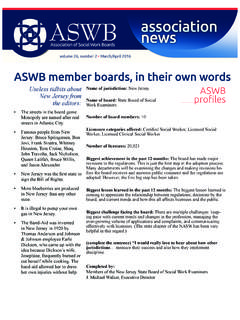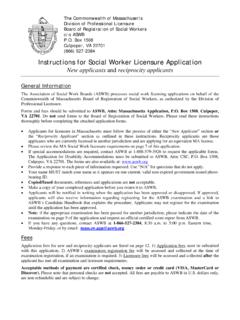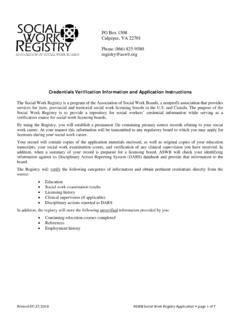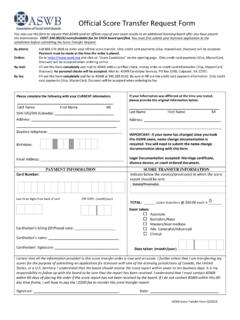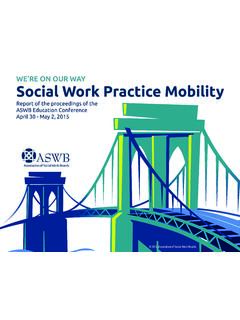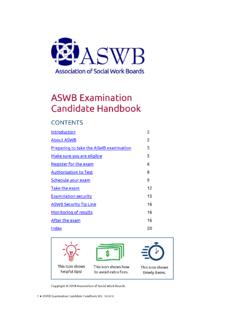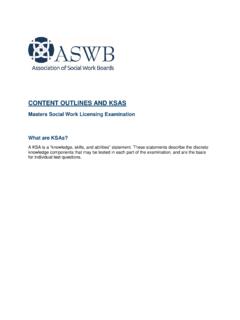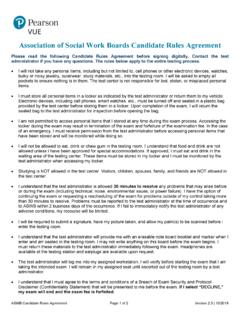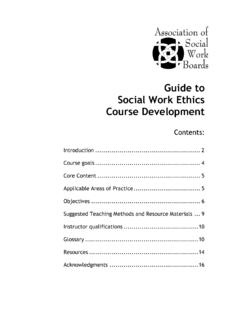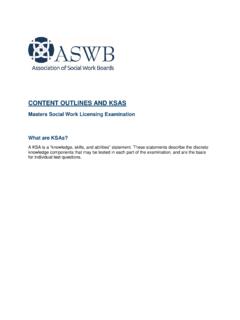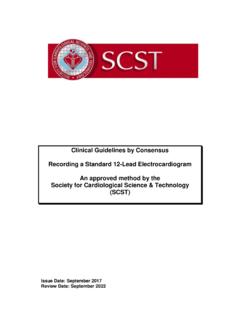Transcription of CONTENT OUTLINES AND KSAS - ASWB
1 CONTENT OUTLINES AND KSAS clinical Social Work Licensing Examination What are KSAs? A KSA is a knowledge,skills, and abilities statement. These statements describe the discrete knowledge components that may be tested in each part of the examination, and are the basis for individual test questions. ASWB Examination Program | clinical KSAs | 2018 Exams 1 ASWB Examination program Knowledge, Skills, and Abilities clinical Examination I. HUMAN DEVELOPMENT, DIVERSITY, AND BEHAVIOR IN THE ENVIRONMENT 24% IA. HUMAN GROWTH AND DEVELOPMENT This section of the exam may include questions on the following topics: Theories of human development throughout the lifespan ( , physical, social, emotional, cognitive, behavioral)
2 The indicators of normal and abnormal physical, cognitive, emotional, and sexual development throughout the lifespan Theories of sexual development throughout the lifespan Theories of spiritual development throughout the lifespan Theories of racial, ethnic, and cultural development throughout the lifespan The effects of physical, mental, and cognitive disabilities throughout the lifespan The interplay of biological, psychological, social, and spiritual factors Basic human needs The principles of attachment and bonding The effect of aging on biopsychosocial functioning Gerontology Personality theories Factors influencing self-image ( , culture, race, religion/spirituality, age, disability, trauma) Body image and its impact ( , identity, self-esteem, relationships, habits)
3 Parenting skills and capacities Basic principles of human genetics The family life cycle Models of family life education in social work practice The impact of aging parents on adult children Systems and ecological perspectives and theories Strengths-based and resilience theories The dynamics and effects of loss, separation, and grief IB. HUMAN BEHAVIOR IN THE SOCIAL ENVIRONMENT This section of the exam may include questions on the following topics: Person-in-Environment (PIE) theory Family dynamics and functioning and the effects on individuals, families, groups, organizations, and communities The dynamics of interpersonal relationships Indicators and dynamics of abuse and neglect throughout the lifespan The effects of physical, sexual, and psychological abuse on individuals, families, groups, organizations, and communities ASWB Examination Program | clinical KSAs | 2018 Exams 2 IB.
4 HUMAN BEHAVIOR IN THE SOCIAL ENVIRONMENT (continued) The characteristics of perpetrators of abuse, neglect, and exploitation The effects of life events, stressors, and crises on individuals, families, groups, organizations, and communities The impact of stress, trauma, and violence Crisis intervention theories The effect of poverty on individuals, families, groups, organizations, and communities The impact of the environment ( , social, physical, cultural, political, economic) on individuals, families, groups, organizations, and communities Social and economic justice Theories of social change and community development The impact of social institutions on society The impact of globalization on clients/client systems ( , interrelatedness of systems, international integration, technology, environmental or financial crises, epidemics) Criminal justice systems The impact of out-of-home placement ( , hospitalization, foster care, residential care, criminal justice system)
5 On clients/client systems Theories of couples development The impact of physical and mental illness on family dynamics Co-occurring disorders and conditions The impact of caregiving on families Psychological defense mechanisms and their effects on behavior and relationships Addiction theories and concepts The effects of addiction and substance abuse on individuals, families, groups, organizations, and communities The indicators of addiction and substance abuse Role theories Feminist theory Theories of group development and functioning Communication theories and styles Theories of conflict IC. DIVERSITY AND DISCRIMINATION This section of the exam may include questions on the following topics.
6 The effect of disability on biopsychosocial functioning throughout the lifespan The effect of culture, race, and ethnicity on behaviors, attitudes, and identity The effects of discrimination and stereotypes on behaviors, attitudes, and identity The influence of sexual orientation on behaviors, attitudes, and identity The impact of transgender and transitioning process on behaviors, attitudes, identity, and relationships Systemic (institutionalized) discrimination ( , racism, sexism, ageism) The principles of culturally competent social work practice Sexual orientation concepts Gender and gender identity concepts ASWB Examination Program | clinical KSAs | 2018 Exams 3 II.
7 ASSESSMENT, DIAGNOSIS, AND TREATMENT PLANNING 30% IIA. BIOPSYCHOSOCIAL HISTORY AND COLLATERAL DATA This section of the exam may include questions on the following topics: The components of a biopsychosocial assessment Techniques and instruments used to assess clients/client systems The types of information available from other sources ( , agency, employment, medical, psychological, legal, or school records) Methods to obtain sensitive information ( , substance abuse, sexual abuse) The principles of active listening and observation The indicators of sexual dysfunction Symptoms of neurologic and organic disorders IIB.
8 ASSESSMENT AND DIAGNOSIS This section of the exam may include questions on the following topics: The factors and processes used in problem formulation Methods of involving clients/client systems in problem identification ( , gathering collateral information) The components and function of the mental status examination Methods to incorporate the results of psychological and educational tests into assessment The indicators of psychosocial stress The indicators, dynamics, and impact of exploitation across the lifespan ( , financial, immigration status, sexual trafficking) The indicators of traumatic stress and violence Methods used to assess trauma Risk assessment methods The indicators and risk factors of the client's/client system's danger to self and others Methods to assess the client's/client system's strengths, resources, and challenges ( , individual, family, group, organization, community)
9 The indicators of motivation, resistance, and readiness to change Methods to assess motivation, resistance, and readiness to change Methods to assess the client s/client system s communication skills Methods to assess the client s/client system s coping abilities The indicators of the client s/client system s strengths and challenges Methods to assess ego strengths The use of the Diagnostic and Statistical Manual of the American Psychiatric Association The indicators of mental and emotional illness throughout the lifespan Biopsychosocial factors related to mental health Biopsychosocial responses to illness and disability Common psychotropic and non-psychotropic prescriptions and over-the-counter medications and
10 Their side effects The indicators of somatization The indicators of feigning illness ASWB Examination Program | clinical KSAs | 2018 Exams 4 IIB. ASSESSMENT AND DIAGNOSIS (continued) Basic medical terminology The indicators of behavioral dysfunction Placement options based on assessed level of care Methods to assess organizational functioning ( , agency assessments) Data collection and analysis methods IIC. TREATMENT PLANNING This section of the exam may include questions on the following topics: Methods to involve clients/client systems in intervention planning Cultural considerations in the creation of an intervention plan The criteria used in the selection of intervention/treatment modalities ( , client/client system abilities, culture, life stage)
